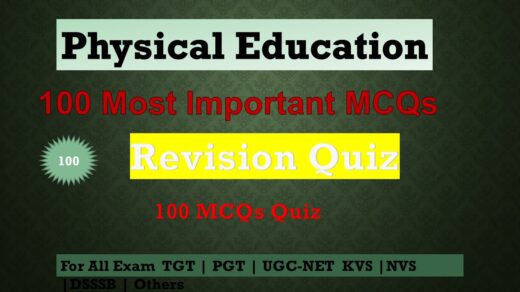Physical Education UGC NET PRATICE SET 1:
The UGC NET Physical Education Exam is a national-level test conducted by the National Testing Agency (NTA) for aspiring lecturers and researchers in the field of Physical Education. It consists of two papers: Paper 1, which tests general teaching and research aptitude, and Paper 2, which is specific to Physical Education.
Paper 2 covers topics such as Exercise Physiology, Sports Psychology, Biomechanics, Kinesiology, Sports Training, Management, and the History of Physical Education. It also includes areas like health education, yoga, and emerging trends in sports and fitness.
The exam is computer-based and features multiple-choice questions. Each correct answer scores two marks, with no negative marking. Candidates must have a strong understanding of theoretical concepts and practical knowledge in physical education.
Qualifying this exam opens doors for teaching positions at universities and eligibility for Junior Research Fellowship (JRF). It is a highly competitive exam, requiring systematic preparation, in-depth study of the syllabus, and staying updated with current trends in sports science and physical education.
Play Physical Education UGC NET PRATICE SET 1 quiz to boost your preparation of PE UGC NET Exam preparation.
Quiz: Questions And Answers:-
Individual who have “made significant achievement in education, culture, development and peace through sports” is awarded with :
The definition “Play consists of responses repeated purely for functional pleasure” is given by :
Identify the disease which is referred to as Hypokinetic disease :
Identify the muscle protein which is not a part of thick filament :
Reynolds Number is a number that can be used to determine whether or not the flow around a object will be turbulent or laminar. If U is Speed of the Projectile, d is Diameter of the sphere and V is Viscosity of the Medium. Then Reynolds Number is calculated by :
Two forces that are equal in magnitude, act in opposite directions at a distance from an axis of rotation, and produces rotation with no translation is known as :
Negatively accelerated learning curve is also called :
Moment to moment changes in perceived physiological activation is called :
The ecology of teaching and learning in physical education helps to understand :
All antibodies are compounds made up of :
The amount of Carbohydrate to be consumed one hour prior to exercise is :
While the trainees practice a movement repeatedly and the coach constantly supervises, helps and makes corrections, the method is termed as :
Which of the characteristics of sports training denotes the process of scientific observation, experimentation, analysis and synthesis ?
Hypotheses in qualitative research studies usually :
A type of sampling used in qualitative research that involves selecting cases that disconfirm the researcher’s expectations and generalizations is referred to as :
Which evaluation promotes high levels of learning among all the students and pinpoints areas where further development and learning are needed ?
If we have a test of 50 items with mean of 30 and standard deviation of 6, what will be the reliability of the test using Kuder Richardson Method ?
The primary focus of supervision must watch :
The Intramural Programmes are an excellent grounds for :
“Play” Theories are :
a. Catharsis Theory b. Attribution Theory
c. Psycho-analytic Theory d. Social Learning Theory
If you liked the Physical Education UGC NET PRATICE SET 1 quiz, feel free to leave a comment or correct any questions that display the wrong answer. Also, subscribe to us on YouTube and try other quizzes on this website to keep your exam preparation on track.



